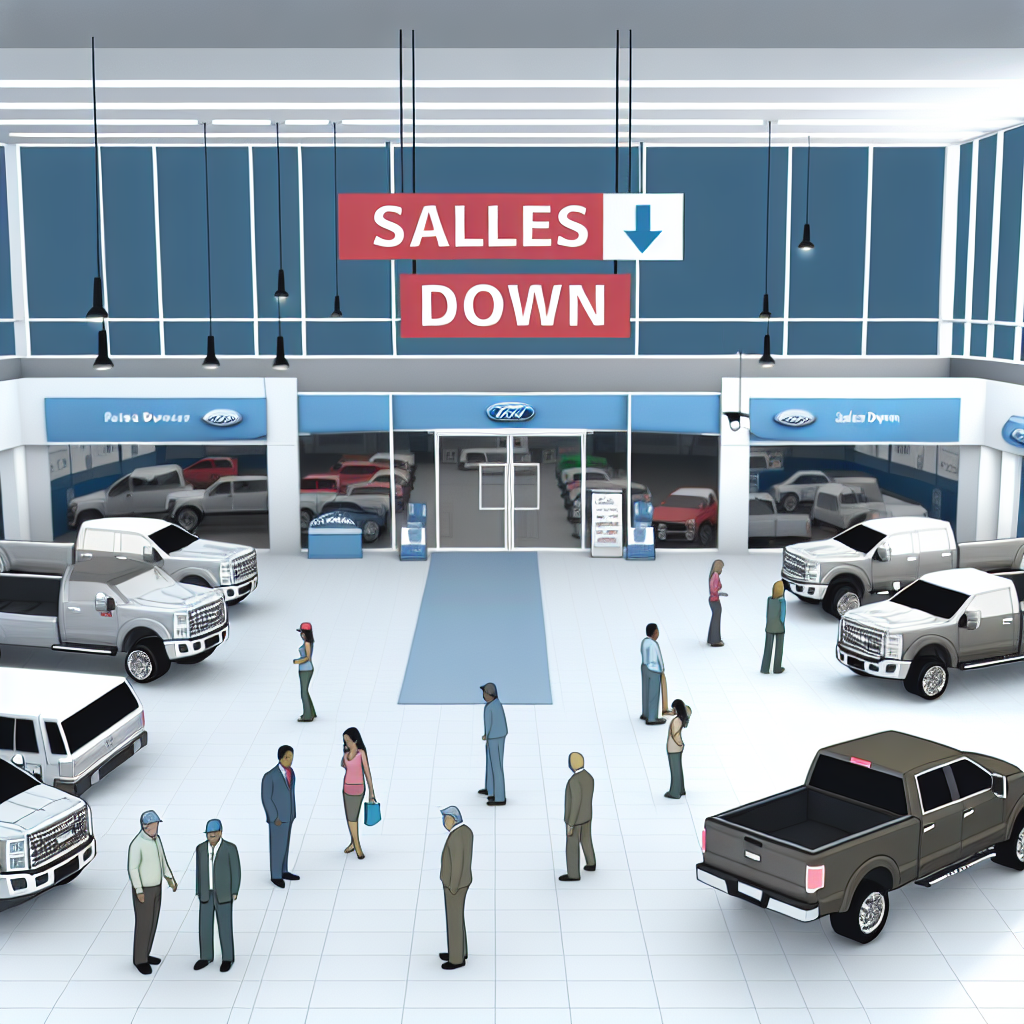In the current economic landscape, truck and trailer dealers find themselves grappling with a staggering 35% decline in sales, a stark indicator of the industry’s shifting dynamics. This downturn is aggravated by a 40% drop in orders, compelling dealers to rethink their marketing strategies and inventory management.
The anticipated increase in parts and service demand that typically follows a sales decline has, instead, been subdued, with reports indicating only single-digit reductions once inflation is accounted for.
Compounding these challenges are the ongoing tariffs that disrupt supply chains and inflate costs, forcing dealers to navigate an increasingly complex market. As they invest in employees and facilities to weather this storm, truck and trailer dealers must adopt a cautious, analytical approach to regain stability in an uncertain environment.
Truck dealers are currently facing significant challenges due to a downturn in sales, leading to increased stress and highlighting the critical importance of effective inventory management.
Psychological Impact on Truck Dealers:
The recent decline in sales has severely affected dealer sentiment. In the second quarter of 2025, dealer business conditions deteriorated to the worst levels recorded in the history of the Trucks, Parts, Service MarketPulse survey. Approximately 65% of dealers anticipate that the latter half of 2025 will continue to present similar challenges. This prolonged period of reduced sales has heightened stress levels among dealers, as they grapple with financial pressures and uncertainty about future market conditions. [source]
Importance of Inventory Management:
Effective inventory management is crucial for mitigating the financial strain associated with sales downturns. Key considerations include:
- Inventory Turnover Rate: Maintaining an optimal inventory turnover rate is essential. The average turnover for dealerships typically ranges between 45-60 days. Failing to achieve this can result in excess stock and missed sales opportunities. [source]
- Holding Costs: The cost of holding unsold vehicles is substantial, averaging around $30-40 per day per vehicle. Efficient inventory management minimizes these expenses, freeing up capital for other priorities and enhancing profitability. [source]
- Impact on Sales: Optimized inventory practices lead to increased sales by ensuring the right mix and availability of vehicles to meet customer demand. This not only boosts revenue but also enhances customer satisfaction. [source]
In summary, the current sales downturn has placed considerable psychological and financial stress on truck dealers. Implementing strategic inventory management practices is vital to navigate these challenges, reduce holding costs, and improve overall profitability.
User Adoption Data in the Truck Dealer Industry
Current user adoption trends in the truck dealer industry reveal a concerning dynamic: while new truck sales are significantly down, there hasn’t been a corresponding rise in service demand as typically expected. Truck sales experienced a notable decline of around 35%, with orders falling by 40% as well. Traditionally, this downturn in sales usually prompts fleet operators to invest in the maintenance of existing vehicles, thereby increasing demand for service and parts. However, evidence suggests that the parts and service sectors have only seen slight declines in single digits, even when adjusted for inflation.
Trends in Service Demand Versus Sales
According to a recent NADA report, commercial truck sales dropped by 6.5% in the first quarter of 2025, echoing a broader trend observed in the market. Although the standard practice in the industry is that service demand increases when sales decline, the most recent data indicates that this historical pattern may not be holding true. Mark Hall stated clearly: “Equipment sales are down, OEMs are saying sales are down, but we have not seen the increase in our parts and service business.”
This discrepancy raises questions about the current state of the service market. Dealers have historically been able to adjust to declines in sales by leveraging their service departments, yet the lack of a boom in service demand amid declining sales is revealing a potential shifting attitude within the industry or among fleet operators. They might be holding back on maintenance expenditures or may not need repairs as frequently as in past downturns.
Conclusion
The intersection of declining truck sales and the subdued service demand presents a unique challenge to truck dealers. As they navigate this complicated landscape, understanding the nuanced relationship between sales trends and service utilization will be critical for long-term strategy and sustainability in the industry. Moving forward, dealers must focus on redefining their service offerings and exploring innovative ways to entice clients back into the service bays, ensuring they’re prepared to adapt to shifting market demands.
References
- NADA Report: Commercial truck sales down 6.5% in Q1 2025
- Truck News: Truck and trailer dealers see a decrease in sales
User Adoption Data in the Truck Dealer Industry
Current user adoption trends in the truck dealer industry reveal a concerning dynamic: while new truck sales are significantly down, there hasn’t been a corresponding rise in service demand as typically expected. Truck sales experienced a notable decline of approximately 35%, with orders falling by 40% as well.
Trends in Service Demand Versus Sales
Traditionally, a downturn in sales prompts fleet operators to invest in the maintenance of existing vehicles, which usually increases demand for service and parts. However, the latest statistics tell a different story. The National Automobile Dealers Association (NADA) reported that despite a solid performance in June, heavy-duty truck sales were down year-over-year by 5% through the second quarter of 2025. Furthermore, commercial truck sales in the U.S. totaled 105,640 units, marking a 6.5% decrease compared to the same period in 2024.
Mark Hall summarized the sentiment in the industry, stating, “Equipment sales are down, OEMs are saying sales are down, but we have not seen the increase in our parts and service business.”
Changing Landscape for Service Demand
The anticipated increase in parts and service demand has not materialized in the same way it historically has during sales downturns. Current reports suggest that the parts and service sectors have only seen slight declines of single digits, even when adjusted for inflation. This prompts dealers to rethink their strategies, as historically, service demand spikes when sales drop.
Dealer Sentiments: Many industry leaders are feeling the pressure. In a recent report, 65% of dealers believe the latter half of 2025 will continue to present challenges due to stagnant service demand paired with declining sales. An aftermarket responder expressed that “We are in uncertain times; business is up and down weekly now. [It’s] very hard to predict.”
Conclusion
The intersection of declining truck sales and subdued service demand presents a unique challenge to truck dealers. Understanding the nuanced relationship between sales trends and service utilization will be critical for long-term strategy and sustainability in the industry. Moving forward, dealers must focus on redefining their service offerings and exploring innovative ways to entice clients back into the service bays, ensuring they are prepared to adapt to shifting market demands.
References
| Dealer Category | Sales Decline (%) | Orders Decline (%) | Parts & Service Demand Change (%) |
|---|---|---|---|
| All Truck Dealers | 35 | 40 | Slightly down in single digits |
| Shoops Freightliner | TBD | TBD | TBD |
| Quality Trailer | TBD | TBD | TBD |
| Kenworth Sales | TBD | TBD | TBD |
Notes: The statistics for specific dealer categories (Stoops Freightliner, Quality Trailer, Kenworth Sales) will need to be populated based on additional data sources and research. The overall percentages provide a general overview based on the observed market trends.
| Dealer Category | Sales Decline (%) | Orders Decline (%) | Parts & Service Demand Change (%) |
|---|---|---|---|
| All Truck Dealers | 35 | 40 | Slightly down in single digits |
| Shoops Freightliner | TBD | TBD | TBD |
| Quality Trailer | TBD | TBD | TBD |
| Kenworth Sales | TBD | TBD | TBD |
Notes: The statistics for specific dealer categories (Stoops Freightliner, Quality Trailer, Kenworth Sales) will need to be populated based on additional data sources and research. The overall percentages provide a general overview based on the observed market trends.
Strategic Responses for Truck Dealers During Sales Decline
As truck and trailer dealers face a significant downturn in sales, there are several strategic responses they can adopt to navigate these challenges and maintain profitability:
1. Built-to-Order (BTO) Strategies
Adopting a built-to-order approach allows dealers to significantly reduce inventory costs. By focusing on customer-specific orders, dealers can minimize the risks associated with overstocking and ensure that capital isn’t tied up in unsold inventory. Tailoring vehicles to specific customer preferences not only enhances customer satisfaction but also reduces holding costs, making it a vital strategy.
2. Effective Inventory Management
During periods of declining sales, effective inventory management is essential. Prioritizing aged inventory can help keep stock moving and prevent depreciation losses. Utilizing advanced inventory management systems allows dealers to track vehicle performance meticulously. Implementing strategies such as organizing the lot to highlight high-demand or aging vehicles can attract customer interest, facilitating sales. According to industry insights, optimizing inventory turnover is crucial in this volatile market.
3. Adapting to Tariff Challenges
Ongoing tariffs present obstacles by inflating vehicle costs. Dealers can mitigate these challenges by:
- Diversifying Revenue Sources: Focus on enhancing pre-owned vehicle operations, expanding service department options, and exploring subscription or mobility services to counterbalance potential revenue losses due to tariffs.
- Strengthening Customer Relationships: Investing in training sales teams on articulating the value propositions that extend beyond price, emphasizing the profitability and advantages of specific models can help address customer concerns effectively.
- Innovative Inventory Management: Employ strategies like more frequent inventory turnover, custom ordering, and data-driven stocking decisions to minimize financial exposure related to tariff-affected inventory.
- Pricing Strategy Adjustments: Establish nuanced pricing approaches, taking into account model-specific price elasticity, competitive positioning, and introducing value-added bundles to sustain sales volume and protect margins.
4. Enhancing Customer Communication
Transparent communication about pricing changes due to tariffs is crucial. Dealers should equip their sales staff with clear talking points to address customer concerns, fostering trust and informed decision-making.
5. Leveraging Digital Tools
Investing in digital showroom enhancements and virtual inventory presentations can help maintain the appearance of a broad selection while stocking limited inventory physically. This approach not only aids in attracting online shoppers but also streamlines the overall sales process.
By implementing these strategies, truck and trailer dealers can more effectively navigate the current sales downturn, adapt to the challenges presented by tariffs, and maintain a competitive edge in a rapidly changing market.

An illustration representing a truck dealer showroom emphasizing a sales decline with a ‘Sales Down’ banner.

An illustration representing a truck dealer showroom emphasizing a sales decline with a ‘Sales Down’ banner.
Analysis of Tariffs Impact on Truck Dealers
The ongoing imposition of tariffs in the automotive sector is reshaping the operational landscape for truck and trailer dealers across the United States. With a staggering 25% tariff on imported vehicles and parts, costs have escalated, forcing dealers to re-evaluate their pricing models and inventory management strategies.
Pricing Challenges and Manufacturer Cost Adjustments
The tariffs have led to significant price increases; estimates suggest a potential addition of $3,000 for domestically manufactured trucks and up to $6,000 for imported models. This surge in expenses poses a challenge for dealers aiming to remain competitive in an increasingly price-sensitive market. Kyle Treadway succinctly captured this sentiment: “Equipment sales are down, OEMs are saying sales are down, but we have not seen the increase in our parts and service business.”
In response to rising costs, dealers are adjusting pricing structures. Many have started reducing discounts or increasing retail prices to protect their margins against escalating acquisition costs. This dynamic has not only influenced new truck pricing but has also trickled down to the used truck market, where increased demand and limited supply due to inventory constraints may further inflate prices. As noted in recent reports, used Class 8 truck sales have surged 23% year-over-year, driving dealers to emphasize their pre-owned inventories to meet consumer demand.
Inventory Availability and Strategic Adaptations
Tariffs have compounded inventory challenges for dealers. With the heightened need for immediate inventory management, some dealers have resorted to stockpiling vehicles and parts ahead of anticipated additional tariffs. This proactive approach, while securing lower costs on inventory acquisition in the short term, introduces significant risks in carrying costs and financial exposure. Mark Hall’s experience highlights this risk: “We thought we had a pretty good idea what they wanted for specs when we ordered inventory.”
Conversely, this scenario also stresses the importance of efficient inventory management. Dealers are required to frequently evaluate and optimize their inventory turnover to avoid excess stock and ensure alignment with fluctuating consumer preferences. Additionally, the growing focus on shifting production to tariff-free regions, as seen with manufacturers like Volvo and Mercedes-Benz moving operations to Mexico, illustrates a long-term strategic adjustment by both producers and dealers to circumvent tariff-related impacts.
Consumer Behavior and Market Dynamics
Consumer behavior has also shifted; purchasers are increasingly rushing to dealer lots to avoid potential price increases linked to tariffs. This temporary surge provides dealers with short-term relief but creates a misalignment in long-term demand sustainability. The increasing uncertainty surrounding the effect of tariffs on future vehicle availability further complicates this delicate balance.
Industry experts predict that the ongoing tariff situation, combined with rising costs, could lead to an estimated 11% decline in truck production by 2026, signaling possible challenges ahead for the trucking industry. The evolving supply chain disruptions and manufacturing cost escalations necessitate that truck dealers not only adapt their pricing and inventory strategies but also their overall business models to remain viable.
In summary, the tariffs have significantly impacted truck and trailer dealers by inflating costs, altering inventory strategies, and shifting consumer purchasing behaviors. As they navigate these complexities, maintaining adaptability will be crucial for their sustainability in an increasingly turbulent market.
References
In conclusion, the current economic environment presents unprecedented challenges for truck dealers, emphasizing the critical need for resilience and adaptability. As sales continue to decline amidst tariffs and fluctuating market demands, it is imperative for dealers to reflect on the insights gathered from this article. The strategic maneuvers outlined, such as rethinking inventory management and embracing built-to-order strategies, are vital to not only surviving but thriving during tough economic times. Now is the time for dealers to actively reconsider their approaches, enhancing communication with clients and leveraging innovative solutions to foster trust and profitability. By embracing change and focusing on strategic adaptability, truck dealers can navigate these turbulent waters more effectively and emerge with a stronger foothold in the industry.
In conclusion, the current economic environment presents unprecedented challenges for truck dealers, emphasizing the critical need for resilience and adaptability. As sales continue to decline amidst tariffs and fluctuating market demands, it is imperative for dealers to reflect on the insights gathered from this article. The strategic maneuvers outlined, such as rethinking inventory management and embracing built-to-order strategies, are vital to not only surviving but thriving during tough economic times. Now is the time for dealers to actively reconsider their approaches, enhancing communication with clients and leveraging innovative solutions to foster trust and profitability. By embracing change and focusing on strategic adaptability, truck dealers can navigate these turbulent waters more effectively and emerge with a stronger foothold in the industry.
Recent Trends in Freight Rates Affecting Truck and Trailer Dealers
Recent trends in freight rates have been largely influenced by escalating tariffs and the broader economic climate, both of which hold significant implications for truck and trailer dealers.
Freight Rate Fluctuations and Demand Changes
The U.S. trucking industry is witnessing notable changes due to economic uncertainties and tariffs:
- Declining Freight Volumes: Major ports, including Los Angeles and Seattle, have reported up to a 35% reduction in container traffic, which translates to a decreased demand for trucking services. This reduction impacts both less-than-truckload carriers and long-haul operators. [source]
- Flatbed Rate Increases: In contrast, flatbed trucking rates have surged, due primarily to steel and lumber shippers stockpiling inventory amid tariff uncertainties. This increase has brought about the highest flatbed pricing at the start of a year since 2017. [source]
Impact on Truck and Trailer Dealers
The fluctuations in freight rates and the changing landscape affect truck and trailer dealers in several ways:
- Reduced Equipment Demand: With the downturn in freight volumes, many carriers have begun shrinking their fleets. For instance, Marten Transport reported a reduction of its total tractors from 3,126 to 2,928 and trailers from 5,539 to 5,164 over one year. Such cuts lead to diminished demand for new trucks and trailers. [source]
- Increased Equipment Costs: The ongoing tariffs on imported truck parts and vehicles have led to inflated purchasing costs. The American Trucking Association estimates tariffs could add up to $35,000 to the price of a new truck. This steep increase dissuades fleet expansion and modernization initiatives. [source]
- Supply Chain Disruptions: The tariffs have led importers to accelerate shipments prior to new rates taking effect, creating a temporary surge in freight demand. However, once tariffs are imposed, a slowdown in imports could follow, resulting in fewer loads available for truckers. Also, complex customs procedures associated with tariff regulations have led to delays at ports, disrupting the flow of goods. [source]
Strategic Considerations for Dealers
To adapt to the evolving challenges, truck and trailer dealers may consider:
- Diversifying Supply Chains: Exploring alternative sourcing options will help mitigate risks linked to tariff-affected regions.
- Adjusting Inventory Levels: Aligning inventory with current demand trends will assist in managing costs effectively and addressing customer needs better.
- Monitoring Market Trends: Staying informed about freight rate fluctuations and economic policies enables proactive decision-making for dealers.
By understanding these shifts within the freight market, truck and trailer dealers can better navigate the complexities of the evolving landscape.
References
- Trump trade war is wrecking hope for 2025 US trucking rebound
- U.S. Freight Market Update
- Tariff deadline set off spike in cross-border trucking rates, data shows

An illustration showing various aspects of freight transportation, including trucks on highways and shipping containers at ports, highlighting the dynamics of freight rates in the trucking industry.
Investing in Employee Training and Facility Upgrades During Slow Sales Periods
In the current turbulent economic climate, investing in employee training and facility upgrades has become imperative for truck and trailer dealerships. As sales have declined by approximately 35% and orders have fallen by 40%, dealers are compelled to adapt to these challenging conditions. This investment not only supports operational efficiency but also fosters a resilient workforce ready to improve customer offerings.
Importance of Employee Training
Investing in employee training during downturns yields several beneficial outcomes for dealerships, including:
- Enhanced Employee Retention and Morale: Continued training signals a company’s commitment to its workforce, enhancing both morale and loyalty. This is crucial during an economic downturn when many employees may feel uncertain about their job security. A study revealing that increased bonds between employees and organizations can lead to higher retention rates underscores the importance of such investments.
- Increased Efficiency and Productivity: Providing training helps employees acquire new skills necessary for maximizing productivity. This is particularly vital when resources are limited, as skilled employees can operate more effectively under tight constraints.
- Adaptability to Change: Economic downturns shift market demands and customer expectations. Training equips employees with the tools to adapt to these changes, positioning dealerships competitively in the marketplace.
- Improved Customer Service: Training enhances employee service capabilities, directly impacting customer satisfaction. A skilled workforce that can efficiently address inquiries and resolve issues fosters client loyalty during tough economic times.
Stephen Burnett from the Kellogg School of Management warns that cutting training during times of economic uncertainty can exacerbate existing challenges. He confirms that ongoing investments in training are critical for developing capabilities that will lead to future successes.
Significance of Facility Upgrades
Simultaneous investment in facility upgrades is equally crucial, particularly for enhancing service and support operations. Considerations include:
- Managing Financial Strain: As economic declines often lead to higher inventory levels, upgrading facilities can streamline operations and reduce carrying costs. A proactive upgrade may alleviate some of the financial pressure restaurants face due to increased floorplan costs resulting from unsold equipment.
- Capitalize on Aftermarket Services: While new sales decrement, the parts market tends to fare better. By upgrading service facilities, dealerships can maximize the steady demand for repairs and maintenance, thereby securing a significant revenue stream even during downturns.
- Improved Operational Efficiency: Enhanced facilities lead to better workflow and reduced downtime, allowing dealerships to serve customers more rapidly and effectively. In an industry where every minute counts, these upgrades can significantly boost productivity and customer satisfaction.
- Long-Term Growth Strategy: As the market begins to recover, well-upgraded facilities will enable dealerships to accommodate increased service demand. Investing during downturns positions dealers for accelerated growth when conditions improve.
Conclusion
In summary, investing in employee training and facility upgrades during sales downturns is a strategic approach that can yield long-term benefits for truck and trailer dealerships. By focusing on developing a skilled workforce and enhancing service capabilities, dealerships can navigate current economic challenges and emerge stronger when the market rebounds.
This dual investment approach not only fosters resilience but also ensures that dealerships remain competitive, adapting to changing market dynamics while maintaining high levels of customer service and satisfaction.

An illustrative image depicting a fleet of trucks arranged in a neat row in a dealership lot, showcasing various models and colors, emphasizing the organization’s focus on inventory management and dealer challenges.
